ABU DHABI —
Iranian officials have worried for years that other nations have been depriving
them of one of their vital water sources. But it was not an upstream dam that
they were worrying about or an aquifer being bled dry.
اضافة اعلان
In 2018, amid a
searing drought and rising temperatures, some senior officials concluded that
someone was stealing their water from the clouds.
“Both Israel and
another country are working to make Iranian clouds not rain,” Brig. Gen. Gholam
Reza Jalali, a senior official in the country’s powerful Revolutionary Guard,
said in a 2018 speech.
 Pilots for the National Center of Meteorology and Seismology during a demonstration cloud seeding flight over in Al-Ain, UAE, on March 3, 2022.
Pilots for the National Center of Meteorology and Seismology during a demonstration cloud seeding flight over in Al-Ain, UAE, on March 3, 2022.
The unnamed country
was the
UAE, which had begun an ambitious cloud-seeding program, injecting
chemicals into clouds to try to force precipitation. The real purpose of these
efforts is not to steal water but simply to make it rain on parched lands.
As the
MENA region
dries up, countries in the region have embarked on a race to develop the
chemicals and techniques that they hope will enable them to squeeze rain drops
out of clouds that would otherwise float fruitlessly overhead.
With 12 of the 19
regional countries averaging less than 25.4cm of rainfall a year, a decline of
20 percent over the past 30 years, their governments are desperate for any
increment of fresh water, and cloud seeding is seen by many as a quick way to
tackle the problem.
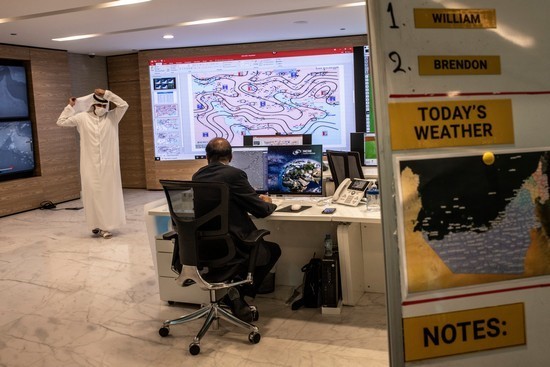 A staff member at the National Center of Meteorology and Seismology monitors current and historical radar data on cloud movements in the region in Abu Dhabi, UAE, on February 28, 2022.
A staff member at the National Center of Meteorology and Seismology monitors current and historical radar data on cloud movements in the region in Abu Dhabi, UAE, on February 28, 2022.
And as wealthy
countries like the UAE pump hundreds of millions of dollars into the effort,
other nations are joining the race, trying to ensure that they do not miss out
on their fair share of rainfall before others drain the heavens dry — despite
serious questions about whether the technique generates enough rainfall to be
worth the effort and expense.
Morocco and
Ethiopia have cloud-seeding programs, as does Iran. Saudi Arabia just started a
large-scale program, and a half-dozen other Middle Eastern and North African
countries are considering it.
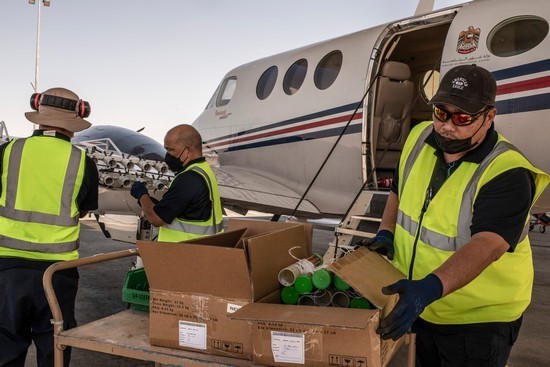 A ground crew for the National Center of Meteorology and Seismology equips an aircraft with hygroscopic flares that release seeding material in to the clouds in Al-Ain, UAE, on March 3, 2022.
A ground crew for the National Center of Meteorology and Seismology equips an aircraft with hygroscopic flares that release seeding material in to the clouds in Al-Ain, UAE, on March 3, 2022.
China has the most
ambitious program worldwide, with the aim of either stimulating rain or halting
hail across half the country. It is trying to force clouds to rain over the
Yangtze River, which is running dry in some spots.
While cloud seeding
has been around for 75 years, experts say the science has yet to be proven. And
they are especially dismissive of worries about one country draining clouds dry
at the expense of others downwind.
The life span of a
cloud, in particular the type of cumulus clouds most likely to produce rain, is
rarely more than a couple of hours, atmospheric scientists say. Occasionally,
clouds can last longer but rarely long enough to reach another country, even in
the Arabian Gulf, where seven countries are jammed close together.
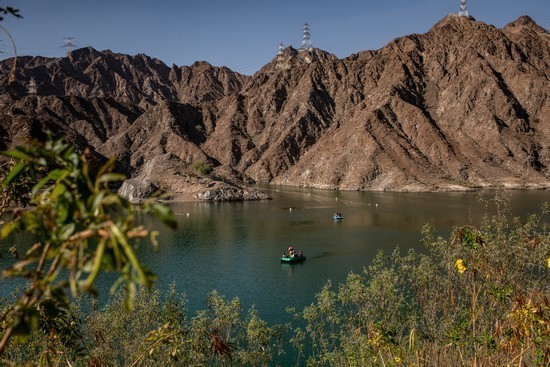 Sightseers on the Raffish Dam’s reservoir in the UAE, on March 1, 2022.
Sightseers on the Raffish Dam’s reservoir in the UAE, on March 1, 2022.
But several
Middle Eastern countries have brushed aside the experts’ doubts and are pushing ahead
with plans to wring any moisture they can from otherwise stingy clouds.
Today, the
unquestioned regional leader is the UAE. As early as the 1990s, the country’s
ruling family recognized that maintaining a plentiful supply of water would be
as important as the nation’s huge oil and gas reserves in sustaining its status
as the financial and business capital of the Arabian Gulf.
 The Netherlands’ exhibition on sustainable water vapor harvesting and agriculture at the Dubai Expo 2020 in Dubai, on March 4, 2022.
The Netherlands’ exhibition on sustainable water vapor harvesting and agriculture at the Dubai Expo 2020 in Dubai, on March 4, 2022.
While there had
been enough water to sustain the tiny country’s population in 1960, when there
were fewer than 100,000 people, by 2020 the population had ballooned to nearly
10 million. And the demand for water soared as well. UAE residents now use
roughly 668 liters per person a day, compared with the world average of 213
liters, according to a 2021 research paper funded by the UAE.
Currently, that
demand is being met by desalination plants. Each facility, however, costs $1
billion or more to build and requires prodigious amounts of energy to run,
especially when compared with cloud seeding, said Abdulla Al-Mandous, director
of the National Center of Meteorology and Seismology in the UAE and the leader
of its cloud-seeding program.
After 20 years of
research and experimentation, the center runs its cloud-seeding program with
near-military protocols. Nine pilots rotate on standby, ready to bolt into the
sky as soon as meteorologists focusing on the country’s mountainous regions
spot a promising weather formation — ideally, the types of clouds that can
build to heights of as much as 12,192m.
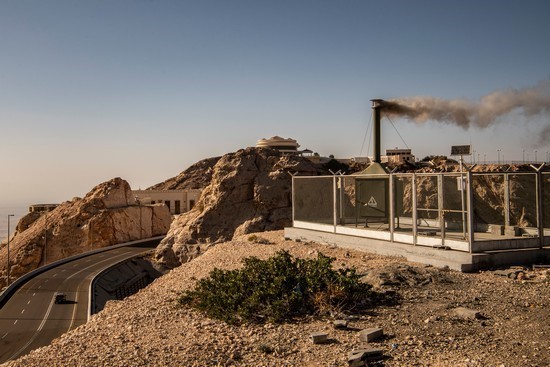 Hygroscopic flares burning during a demonstration on Hatta Mountain in the United Arab Emirates, on March 3, 2022.
Hygroscopic flares burning during a demonstration on Hatta Mountain in the United Arab Emirates, on March 3, 2022.
The UAE uses two
seeding substances: the traditional material made of silver iodide and a newly
patented substance developed at Khalifa University in
Abu Dhabi that uses
nanotechnology that researchers there say is better adapted to the hot, dry
conditions in the Arabian Gulf. The pilots inject the seeding materials into
the base of the cloud, allowing it to be lofted tens of thousands of feet by
powerful updrafts.
And then, in
theory, the seeding material, made up of hygroscopic (water-attracting)
molecules, bonds to the water vapor particles that make up a cloud. That
combined particle is a little bigger and, in turn, attracts more water vapor
particles until they form droplets, which eventually become heavy enough to
fall as rain — with no appreciable environmental effect from the seeding
materials, scientists say.
That is in theory.
But many in the scientific community doubt the efficacy of cloud seeding
altogether. A major stumbling block for many atmospheric scientists is the
difficulty, perhaps the impossibility, of documenting net increases in
rainfall.
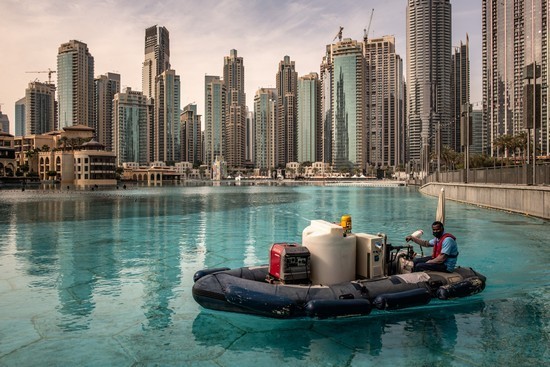 An artificial lake in Dubai, in the UAE, on March 5, 2022. Artificial lakes are helping fuel an insatiable demand for water in the UAE.
An artificial lake in Dubai, in the UAE, on March 5, 2022. Artificial lakes are helping fuel an insatiable demand for water in the UAE.
“The problem is
that once you seed, you can’t tell if the cloud would have rained anyway,” said
Alan Robock, an atmospheric scientist at Rutgers University and an expert in
evaluating climate engineering strategies.
Another problem is
that the tall cumulus clouds most common in summer in the UAE and nearby areas
can be so turbulent that it is difficult to determine if the seeding has any
effect, said Roy Rasmussen, a senior scientist and an expert in cloud physics
at the National Center for Atmospheric Research in Boulder, Colorado.
Israel, a pioneer
in cloud seeding, halted its program in 2021 after 50 years because it seemed
to yield at best only marginal gains in precipitation. It was “not economically
efficient,” said Pinhas Alpert, an emeritus professor at the University of Tel
Aviv who did one of the most comprehensive studies of the program.
Despite the
difficulties of gathering data on the efficacy of cloud seeding, Mandous said
the UAE’s methods were yielding at least a 5 percent increase in rain annually
— and almost certainly far more. But he acknowledged the need for data covering
many more years to satisfy the scientific community.
Over New Year’s
weekend, said Mandous, cloud seeding coincided with a storm that produced
nearly 14.2cm of rain in three days — more precipitation than the UAE often
gets in a year.
In the tradition of
many scientists who have tried to modify the weather, he is ever optimistic.
There is the new cloud-seeding nanosubstance, and if the UAE just had more
clouds to seed, he said, maybe they could make more rain for the country.
And where would
those extra clouds come from?
“Making clouds is very difficult,” he acknowledged. “But,
who knows, maybe God will send us somebody who will have the idea of how to
make clouds.”
Read more Odd and Bizarre
Jordan News



